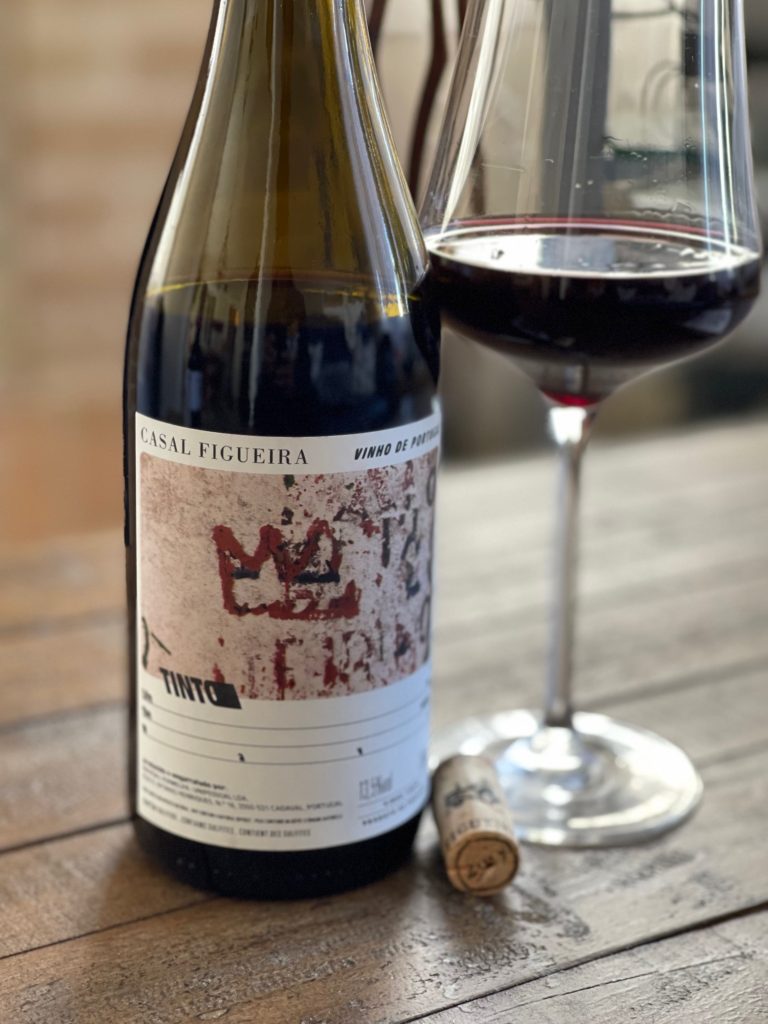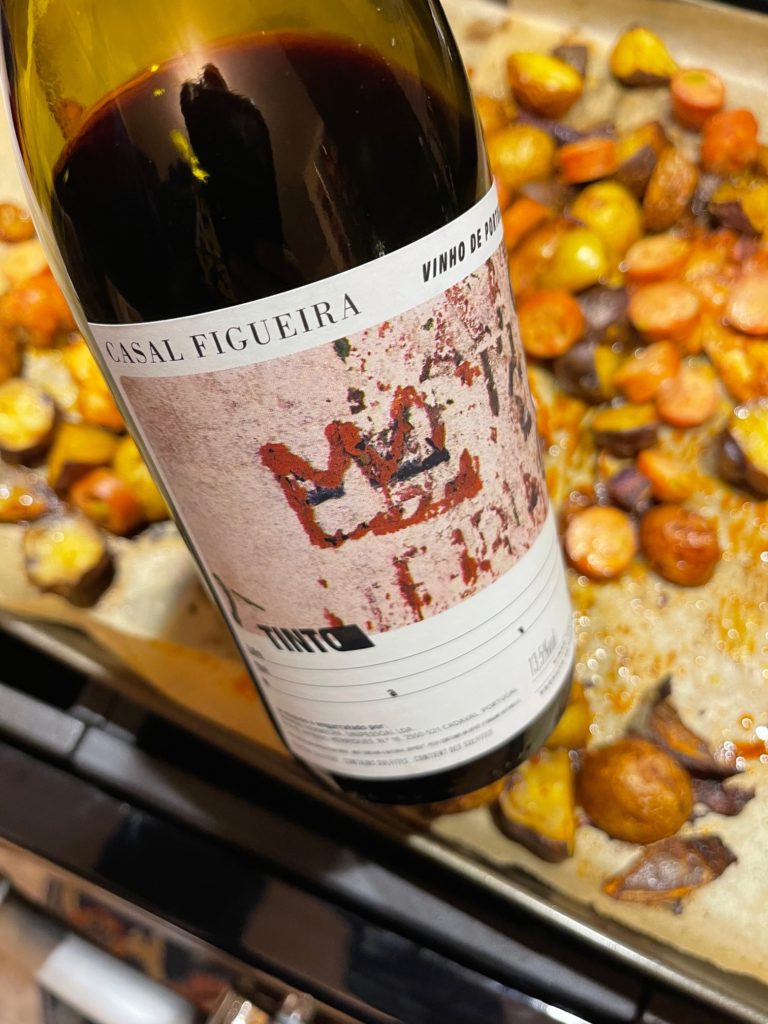When pushed to suffer, like all good masochists do, this grape magically evolves into an intense and aromatic wine with red berry and floral aromas.
Gabriel Opaz – Catavino
This month the Wine Pairing Weekend group of food and wine writers are exploring new-to-us grape varieties.
I recently wrote a book review of “Foot Trodden-Portugal And The Wines That Time Forgot” The book review also featured a wine pairing with the 2017 Casal Figueira “Tinto”, a wine that is 100% Castelão – a new to me grape variety indigenous to Portugal.
About Castelão
Castelão is one of the most cultivated varieties in the Southern Portugal of the country, mainly in the regions of Tejo, Lisbon, Península de Setúbal and Alentejo. It thrives in hot climates and dry, sandy soils.
Physically, this little grape is tough, pooh poohing fertile soil in moderate climates for dry, sandy and intensely hot temperatures. When pushed to suffer, like all good masochists do, this grape magically evolves into an intense and aromatic wine with red berry and floral aromas. Consisting of small bunches of little dark skinned berries, this variety typically produces smooth and well balanced wines with good aging potential as a result of its fondness for oak explains Gabriel Opaz of Catavino
It is among the most planted grapes in Portugal. It is well-suited to the Portuguese predilection for blended wines, but, as in this case, if vinified with care may produce wonderful varietal wines.
2017 Casal Figueira “Tinto”
Casal Figueira is a project focused on neglected old-vine local cultivars. It was founded by Antonio Carvalho and his wife, an artist and painter Marta Soares.
Sadly, Antonio suffered heart failure while treading grapes in 2009. Marta had no chance mourn because the juice was pressed and fermenting. She wasn’t a trained winemaker, but she had been Antonio’s “cellar rat” for a decade. With no time to waste, she decided to continue making the wine. She threw herself into winemaking and found a way to finish what Antonio started.
Today, she brings an artist’s sensibility to making minimal intervention wine. Here’s an excellent profile of her journey written by Foot Trodden co-author Simon J. Woolf.
The terroir is not especially sexy on paper. The vineyards are studded around the Serra de Montejunto, a mountain located just about an hour north of Lisbon. They take the IGP Vinho Regional designation rather than the more prestigious Óbidos explains Rock Juice, where I purchased the wine.

Tasting Note:
This alluring wine pours a ruby violet color with raspberry, plum skin, dry earth, and a hint of mint with a very appealing florality. On the palate, it’s medium-bodied with vibrant, mouth-watering acidity and chalky tannins. It shows black raspberry, red plum, black cherry, black tea flavors with nuanced spice notes and a very appealing saline minerality. 13.5% ABV; 250 cases; SPR – $38
Vineyard/cellar stats: 100% Castelão. Organic and biodynamic farming; 70 year old, own-rooted vines on clay and sand soils; 200m elevation; whole cluster fermentation in stainless steel; short cold maceration, elevage continues in stainless steel with lees, no battonage or pump-overs; no chemical additives; bottled unfined/unfiltered and minimal So2.
Food Pairing
We paired this wine with Sheet Pan Baked Seville Chicken, Sausage, and Vegetables – a recipe with flavors similar to dishes from southern Spain, thanks to a healthy dose of smoked paprika and smoked sausage (I used Chicken Andouille).

The wine’s freshness and dark fruit profile were a wonderful complementary pairing for dish.
If you’re looking for more wine and food pairing inspiration, I invite you to see what grape varieties and pairing my fellow Wine Pairing Weekend writers discovered:
- A Day in the Life on the Farm invites you to Join in the Fun as We Explore New Varietals and Share our Discoveries
- Culinary Adventures with Camilla is Exploring Pineau d’Aunis Rosé: Two Bottles and Chicken Two Ways
- Crushed Grape Chronicles shares Nosiola – a disappearing Northern Italian variety
- Our Good Life discovers Montepulciand d’Abruzzo and Italian Stuffed Peppers
- Avvinare is Exploring Ancient Grapes Prokupe and Vranac At Kosovo’s Stone Castle
- The Quirky Cork shares Discovering Asproudi, a Re-Emerging Greek Grape
- Wineivore:introduces us to Biodynamic Portugese Sparklers with Goan Cuisine
- ENOFYLZ Wine Blog serves up A Taste of Castelão; 2017 Casal Figueira “Tinto”
- Cooking Chat has a Pork Tenderloin Pasta Recipe with a New Italian Wine
- Vino Travels pours Barone di Serramarrocco Pignatello with Barbequed Ribs
- Gwendolyn Alley Wine Predator invites us to Discover Portugal’s Native Grapes in Esporão Organic Blends Paired with Alentejo Pork and Clams and Discover Portugal’s Native Grapes From Three Regions Paired with Peri Peri Chicken
If you’re up early enough, please join our Twitter Chat on Saturday, March 12, at 8 AM PT. Just follow the #WinePW hashtag
________________________________________________________________________
Follow me on Twitter, Facebook, and Instagram and for all things wine. As a wino with latent foodie tendencies, you’ll also find plenty of food and wine pairings, and wine related travel stuff! Become a fan and join ENOFYLZ Wine Blog on Facebook. Cheers!
Copyright Notice: This entire site is Copyrighted 2010-2022. All Rights Reserved. No unauthorized copying of any section of this site is permitted. If you wish to use any part of this site, contact me. For information on Copyright Law, see the official U.S. Copyright Office home page.
I’m so glad that my chosen theme worked so well with your recent book review. Thanks for joining me in this exploration.
Thanks for hosting this wonderful theme Wendy!
I just love your tasting notes! I know so little about Portuguese grapes and wines, thank you for the introduction.
Thanks for the kinds words on my TN Andrea! Glad I could make the introduction!
What a great opportunity. It worked well with our theme. I am getting more interested in Portuguese wines now.
Thanks Terri! Portugal has been a bit of an underdog when it comes to wine. It really has some wonderful values wines that are more challenging to find in other countries.
LOL a masochistic grape! What a great biodynamic wine find. I have been liking the selections I’ve seen on Rock Juice and the many indigenous Portugese varietals that we just don’t see enough of. Thanks for highlighting one of them!
Thanks Deanna! I think Rock Juice is a great resource for “natural” wine.
First, the book sounds fascinating and thank you for the link to the article on Marta Soares. There are so many great varieties in Portugal that I want to explore. Thanks for adding another to my list!
Thanks Robin. There is some much wonderful wine to discover world wine is there? Portugal has been a bit of an underdog, which is part of their appeal for me.
I’ve apparently had Castelão at least once before but now have a greater appreciation upon reading your piece. And that chicken & sausage dish sounds like great pairing!
Thanks so much David. We really enjoyed the pairing!